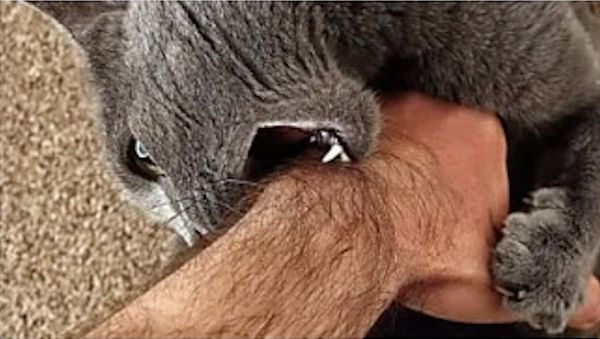Anyone who has a cat knows that their quirky behavior can sometimes leave you puzzled—especially when they suddenly give you a little bite. If you’ve ever wondered what that nip really means, you’re not alone. Cats communicate in a variety of ways, and biting is one of their subtle—or not-so-subtle—methods of sending a message. Let’s explore the most common reasons your feline friend might be sinking its teeth into you and how to respond appropriately.
Playfulness: More Than Just Fun
Cats are natural hunters, and their playfulness is often an extension of those instincts. If your cat bites you while playing, chances are they’re just mimicking hunting behavior. These playful bites are usually gentle and don’t break the skin, but they can still catch you off guard. Kittens and younger cats, especially, are prone to rough play that includes nipping at your hands or feet.
It’s important not to encourage this behavior. If your cat sees your hands or feet as toys, this habit can continue into adulthood, where their bites become more forceful and can cause harm. Instead, redirect their playful energy to toys designed for interactive play. This will keep your fingers safe and help them learn boundaries from a young age.

Affectionate “Love Bites”
Sometimes, cats bite to show affection—often referred to as “love bites.” These nibbles are typically gentle and occur when the cat is feeling particularly content, perhaps while being petted. According to Samantha Bell from Best Friends Animal Society, “They may be saying, ‘I’m enjoying this interaction, but it’s becoming too much for me. I’m nearing my limit.’”
Cats are creatures of boundaries, and while they may enjoy being close to you, there’s always a point where the affection becomes overwhelming. These bites can be their way of asking for a break or signaling they’ve had enough petting. Recognizing this behavior can strengthen your bond, as it allows you to respect their limits.

Overstimulation: When Enough Is Enough
Even the most cuddly cat has a threshold for how much physical contact they can tolerate. Overstimulation happens when a cat becomes overwhelmed by too much petting or handling, leading them to bite as a means of saying “stop.” It’s not a sign of aggression but a clear indication that they need some space to decompress.
You might notice other signs that your cat is becoming overstimulated before the bite happens. These can include flicking their tail, flattening their ears, or tensing their body. Paying attention to these cues can help you avoid a bite and respect their need for a break.
Fear or Stress: Defensive Reactions
Fear is one of the most common reasons a cat might bite. If a cat feels threatened, stressed, or cornered, they will likely bite to protect themselves. This kind of biting is often sharp and more aggressive, intended to warn or defend. Whether it’s from loud noises, unfamiliar environments, or sudden movements, a fearful cat’s bite is their way of saying, “Stay back!”
Understanding your cat’s triggers is crucial for reducing fear-based bites. Create a calm environment and give them plenty of safe spaces where they can retreat when feeling overwhelmed. A peaceful cat is less likely to resort to defensive biting.

Pain or Discomfort: A Silent Cry for Help
Sometimes a bite is not about behavior but about underlying pain. If your cat suddenly begins biting when they normally don’t, it could be a sign of discomfort or an illness that isn’t immediately apparent. Cats are masters of hiding pain, and a bite might be their way of letting you know something is wrong.
If your usually affectionate cat starts biting seemingly out of the blue, it’s a good idea to schedule a visit with your veterinarian. A check-up can help rule out any health problems that might be causing your feline to act out.
Territorial Behavior: Marking Their Domain
Cats are territorial animals, and biting can sometimes be a way to assert dominance or defend their space. This is more common in multi-pet households or when new animals or humans are introduced into their environment. Whether it’s their favorite spot on the couch or a specific area of the house, cats will use biting to reinforce their claim over what they consider “theirs.”
This behavior may also arise in situations where they feel insecure about their place in the home hierarchy. Providing plenty of resources like toys, litter boxes, and climbing spaces can help mitigate territorial stress.

How to Handle Cat Bites Safely
While most cat bites are harmless, it’s essential to treat them with caution due to the risk of infection. Cats’ sharp teeth can penetrate deeply, allowing bacteria from their mouths to enter your skin. If you’re bitten, immediately wash the area with soap and water. Apply an antiseptic and cover the wound with a sterile bandage to protect against further contamination.
In cases where the bite is deep or swelling occurs, seek medical attention, as cat bites can lead to serious infections like cellulitis. Ignoring a bite could result in complications that are much more challenging to treat.
Conclusion: Decoding Your Cat’s Communication
Cats may not be able to speak, but their behavior speaks volumes. Whether they’re feeling playful, affectionate, or defensive, understanding the reasons behind a cat bite can enhance your relationship with your feline companion. By recognizing the context and knowing how to respond, you’ll be better equipped to interpret their signals, making both you and your cat happier in the long run. Remember, the key is in learning their language and respecting their boundaries—it’s all part of being a responsible and loving cat owner.
